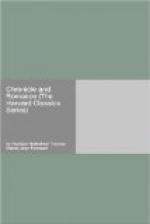Other pernicious beasts we have not, except you repute the great plenty of red and fallow deer whose colours are oft garled white and black, all white or all black, and store of conies amongst the hurtful sort. Which although that of themselves they are not offensive at all, yet their great numbers are thought to be very prejudicial, and therefore justly reproved of many, as are in like sort our huge flocks of sheep, whereon the greatest part of our soil is employed almost in every place, and yet our mutton, wool, and felles never the better cheap. The young males which our fallow deer do bring forth are commonly named according to their several ages: for the first year it is a fawn, the second a pricket, the third a sorel, the fourth a soare, the fifth a buck of the first head, not bearing the name of a buck till he be five years old: and from henceforth his age is commonly known by his head or horns. Howbeit this notice of his years is not so certain but that the best woodman may now and then be deceived in that account: for in some grounds a buck of the first head will be as well headed as another in a high rowtie soil will be in the fourth. It is also much to be marvelled at that, whereas they do yearly mew and cast their horns, yet in fighting they never break off where they do grife or mew. Furthermore, in examining the condition of our red deer, I find that the young male is called in the first year a calf, in the second a broket, the third a spay, the fourth a staggon or stag, the fifth a great stag, the sixth a hart, and so forth unto his death. And with him in degree of venerie are accounted the hare, boar, and wolf. The fallow deer, as bucks and does, are nourished in parks, and conies in warrens and burrows. As for hares, they run at their own adventure, except some gentleman or other (for his pleasure) do make an enclosure for them. Of these also the stag is accounted for the most noble game, the fallow deer is the next, then the roe, whereof we have indifferent store, and last of all the hare, not the least in estimation, because the hunting of that seely beast is mother to all the terms, blasts, and artificial devices that hunters do use. All which (notwithstanding our custom) are pastimes more meet for ladies and gentlewomen to exercise (whatsoever Franciscus Patritius saith to the contrary in his Institution of a Prince) than for men of courage to follow, whose hunting should practise their arms in tasting of their manhood, and dealing with such beasts as eftsoons will turn again and offer them the hardest, rather than their horses’ feet which many times may carry them with dishonour from the field.[2]...
[2] Here follows
a discourse on ancient boar hunting, exalting
it above the degenerate
sports of the day. This ends the
chapter on “savage
beasts.”—W.




